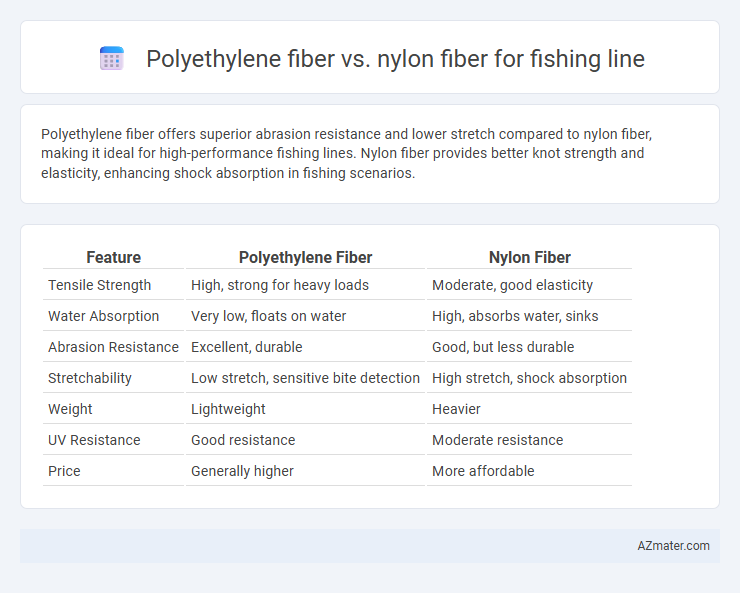Polyethylene fiber offers superior abrasion resistance and lower stretch compared to nylon fiber, making it ideal for high-performance fishing lines. Nylon fiber provides better knot strength and elasticity, enhancing shock absorption in fishing scenarios.
Table of Comparison
| Feature | Polyethylene Fiber | Nylon Fiber |
|---|---|---|
| Tensile Strength | High, strong for heavy loads | Moderate, good elasticity |
| Water Absorption | Very low, floats on water | High, absorbs water, sinks |
| Abrasion Resistance | Excellent, durable | Good, but less durable |
| Stretchability | Low stretch, sensitive bite detection | High stretch, shock absorption |
| Weight | Lightweight | Heavier |
| UV Resistance | Good resistance | Moderate resistance |
| Price | Generally higher | More affordable |
Introduction to Fishing Line Materials
Polyethylene fiber, commonly known as Dyneema or Spectra, offers exceptional strength-to-weight ratio and low stretch, making it ideal for high-performance fishing lines requiring sensitivity and durability. Nylon fiber, often used in monofilament lines, provides superior elasticity and abrasion resistance, enhancing knot strength and flexibility for varied fishing conditions. Both materials serve distinct roles in line design, with polyethylene favored for braided lines and nylon preferred for monofilament applications.
Overview of Polyethylene Fiber Characteristics
Polyethylene fiber, primarily used in fishing lines, is renowned for its exceptional strength-to-weight ratio and high abrasion resistance, making it ideal for demanding aquatic environments. This fiber exhibits low water absorption, ensuring minimal stretch and consistent performance, while its low density allows fishing lines to float or remain near the surface. Compared to nylon fiber, polyethylene offers superior UV resistance and durability, enhancing the lifespan and reliability of fishing lines under prolonged exposure to sunlight and harsh water conditions.
Key Properties of Nylon Fiber
Nylon fiber offers exceptional elasticity and abrasion resistance, making it highly suitable for fishing lines that require durability and flexibility under tension. Its superior knot strength and ability to absorb shock reduce line breakage during sudden pulls, outperforming polyethylene fibers in scenarios demanding resilience. Nylon's hydrophilic nature provides better handling and less memory, enhancing casting performance compared to the stiffer, low-stretch polyethylene alternatives.
Strength and Durability Comparison
Polyethylene fiber, specifically Ultra-High-Molecular-Weight Polyethylene (UHMWPE), offers superior tensile strength and abrasion resistance compared to nylon fiber, making it highly durable for fishing lines exposed to rough conditions. Nylon fibers provide excellent elasticity and knot strength but tend to absorb water, which can reduce overall strength and increase wear over time. Polyethylene fishing lines maintain their strength and durability while being lightweight and resistant to UV damage, outperforming nylon in longevity and performance under harsh environments.
Stretch and Sensitivity Differences
Polyethylene fibers, like Spectra or Dyneema, have extremely low stretch (around 1-3%), providing high sensitivity and immediate hook-setting power for fishing lines. Nylon fibers generally exhibit higher stretch rates (20-30%), offering better shock absorption but reduced sensitivity compared to polyethylene lines. The minimal elongation of polyethylene enhances bite detection, while nylon's stretch helps prevent line breakage under sudden loads.
Water Absorption and Performance
Polyethylene fiber exhibits extremely low water absorption, making it less prone to swelling and maintaining consistent strength and sensitivity in fishing lines compared to nylon fiber. Nylon fiber absorbs significantly more water, which can lead to increased stretch, reduced sensitivity, and weakened performance when wet. For fishing lines, polyethylene fibers like Dyneema or Spectra provide superior durability, minimal water absorption, and enhanced casting distance, making them the preferred choice over nylon in wet environments.
Abrasion Resistance Analysis
Polyethylene fibers, commonly used in fishing lines such as Spectra and Dyneema, exhibit superior abrasion resistance due to their high tensile strength and low friction coefficient, allowing them to withstand repeated contact with rough surfaces and sharp objects. Nylon fibers, while offering better stretch and knot strength, tend to suffer from lower abrasion resistance because of their higher friction and susceptibility to surface wear. For anglers prioritizing durability and longevity in harsh, rocky environments, polyethylene fiber lines provide a significant advantage in abrasion resistance over nylon alternatives.
Knot Strength and Handling
Polyethylene fiber fishing lines, such as Dyneema or Spectra, offer high knot strength with minimal breakage, making them ideal for securing reliable knots under tension. Nylon fibers generally provide superior handling due to their elasticity, allowing knots to cinch tightly and resist slippage during casting and retrieval. The choice between polyethylene and nylon depends on balancing knot security with ease of handling, where polyethylene excels in strength and nylon in knot flexibility.
Cost and Availability
Polyethylene fiber fishing lines, such as those made from Dyneema or Spectra, offer high strength-to-weight ratios and are widely available at competitive prices due to mass production and popular demand in sport fishing. Nylon fiber lines, often used in monofilament types, generally cost less upfront but have lower tensile strength and require thicker diameters for comparable performance, making them less efficient for specialized applications. Availability of polyethylene fibers is increasing rapidly across global markets, while nylon remains more accessible in budget fishing gear and general use due to its established manufacturing infrastructure.
Choosing the Right Fiber for Your Fishing Needs
Polyethylene fiber offers excellent strength-to-weight ratio and exceptional resistance to water absorption, making it ideal for saltwater fishing where durability and minimal stretch are crucial. Nylon fiber provides superior abrasion resistance and elasticity, which enhances knot strength and shock absorption, benefiting anglers targeting species that require a more forgiving line. Selecting the right fiber for fishing lines depends on factors like water type, target species, and required line sensitivity, ensuring optimal performance and reliability during fishing expeditions.

Infographic: Polyethylene fiber vs Nylon fiber for Fishing line
 azmater.com
azmater.com